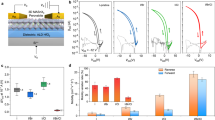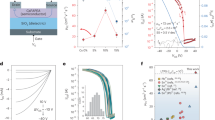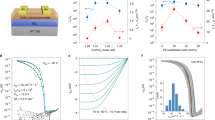Abstract
The engineering of tin halide perovskites has led to the development of p-type transistors with field-effect mobilities of over 70 cm2 V−1 s−1. However, due to their background hole doping, these perovskites are not suitable for n-type transistors. Ambipolar lead halide perovskites are potential candidates, but their defective nature limits electron mobilities to around 3–4 cm2 V−1 s−1, which makes the development of all-perovskite logic circuits challenging. Here we report formamidinium lead iodide perovskite n-type transistors with field-effect mobilities of up to 33 cm2 V−1 s−1 measured in continuous bias mode. This is achieved through strain relaxation of the perovskite lattice using a methylammonium chloride additive, followed by suppression of undercoordinated lead through tetramethylammonium fluoride multidentate anchoring. Our approach stabilizes the alpha phase, balances strain and improves surface morphology, crystallinity and orientation. It also enables low-defect perovskite–dielectric interfaces. We use the transistors to fabricate unipolar inverters and eleven-stage ring oscillators.
This is a preview of subscription content, access via your institution
Access options
Access Nature and 54 other Nature Portfolio journals
Get Nature+, our best-value online-access subscription
$29.99 / 30 days
cancel any time
Subscribe to this journal
Receive 12 digital issues and online access to articles
$119.00 per year
only $9.92 per issue
Buy this article
- Purchase on Springer Link
- Instant access to full article PDF
Prices may be subject to local taxes which are calculated during checkout




Similar content being viewed by others
Data availability
Source data are provided with this paper. Additional data related to this work are available via figshare at https://doi.org/10.6084/m9.figshare.25505182 (ref. 50).
Code availability
All codes (software) used in the calculation and visualization are publicly available and the condition of their use in the publication is an appropriate citation.
References
Kagan, C., Mitzi, D. & Dimitrakopoulos, C. Organic-inorganic hybrid materials as semiconducting channels in thin-film field-effect transistors. Science 286, 945–947 (1999).
Lin, Y.-H., Pattanasattayavong, P. & Anthopoulos, T. D. Metal-halide perovskite transistors for printed electronics: challenges and opportunities. Adv. Mater. 29, 1702838 (2017).
Paulus, F., Tyznik, C., Jurchescu, O. D. & Vaynzof, Y. Switched-on: progress, challenges, and opportunities in metal halide perovskite transistors. Adv. Funct. Mater. 31, 2101029 (2021).
Zhu, H., Liu, A. & Noh, Y.-Y. Recent progress on metal halide perovskite field-effect transistors. J. Inf. Disp. 22, 1–12 (2021).
She, X. J. et al. A solvent-based surface cleaning and passivation technique for suppressing ionic defects in high-mobility perovskite field-effect transistors. Nat. Electron. 3, 694–703 (2020).
Matsushima, T. et al. Solution-processed organic–inorganic perovskite field-effect transistors with high hole mobilities. Adv. Mater. 28, 10275–10281 (2016).
Gao, Y. et al. Highly stable lead-free perovskite field-effect transistors incorporating linear π-conjugated organic ligands. J. Am. Chem. Soc. 141, 15577–15585 (2019).
Zhu, H. et al. Perovskite and conjugated polymer wrapped semiconducting carbon nanotube hybrid films for high-performance transistors and phototransistors. ACS Nano 13, 3971–3981 (2019).
Zhu, H. et al. High-performance and reliable lead-free layered-perovskite transistors. Adv. Mater. 32, 2002717 (2020).
Liang, A. et al. Ligand-driven grain engineering of high mobility two-dimensional perovskite thin-film transistors. J. Am. Chem. Soc. 143, 15215–15223 (2021).
Shao, S. et al. Field-effect transistors based on formamidinium tin triiodide perovskite. Adv. Funct. Mater. 31, 2008478 (2021).
Yusoff, A. R. B. M. et al. Ambipolar triple cation perovskite field effect transistors and inverters. Adv. Mater. 29, 1602940 (2017).
Kim, H. P. et al. A hysteresis-free perovskite transistor with exceptional stability through molecular cross-linking and amine-based surface passivation. Nanoscale 12, 7641–7650 (2020).
Zhu, H. et al. High-performance hysteresis-free perovskite transistors through anion engineering. Nat. Commun. 13, 1741 (2022).
Li, F. et al. Ambipolar solution-processed hybrid perovskite phototransistors. Nat. Commun. 6, 8238 (2015).
Liu, A. et al. High-performance inorganic metal halide perovskite transistors. Nat. Electron. 5, 78–83 (2022).
Zhu, H. et al. Tin perovskite transistors and complementary circuits based on A-site cation engineering. Nat. Electron. 6, 650–657 (2023).
Yu, W. et al. Single crystal hybrid perovskite field-effect transistors. Nat. Commun. 9, 5354 (2018).
Liu, A. et al. Modulation of vacancy-ordered double perovskite Cs2SnI6 for air-stable thin-film transistors. Cell Rep. Phys. Sci. 3, 100812 (2022).
Senanayak, S. P. et al. Charge transport in mixed metal halide perovskite semiconductors. Nat. Mater. 22, 216–224 (2023).
Wang, G. et al. Wafer-scale growth of large arrays of perovskite microplate crystals for functional electronics and optoelectronics. Sci. Adv. 1, e1500613 (2015).
Li, D. et al. Size-dependent phase transition in methylammonium lead iodide perovskite microplate crystals. Nat. Commun. 7, 11330 (2016).
Senanayak, S. P. et al. Understanding charge transport in lead iodide perovskite thin-film field-effect transistors. Sci. Adv. 3, e1601935 (2017).
Jeong, J. et al. Pseudo-halide anion engineering for α-FAPbI3 perovskite solar cells. Nature 592, 381–385 (2021).
Min, H. et al. Efficient, stable solar cells by using inherent bandgap of α-phase formamidinium lead iodide. Science 366, 749–753 (2019).
Chin, X. Y., Cortecchia, D., Yin, J., Bruno, A. & Soci, C. Lead iodide perovskite light-emitting field-effect transistor. Nat. Commun. 6, 7383 (2015).
Kim, M. et al. Methylammonium chloride induces intermediate phase stabilization for efficient perovskite solar cells. Joule 3, 2179–2192 (2019).
Cheng, Z. et al. How to report and benchmark emerging field-effect transistors. Nat. Electron. 5, 416–423 (2022).
Suzuki, A. & Oku, T. Effects of mixed-valence states of Eu-doped FAPbI3 perovskite crystals studied by first-principles calculation. Mater. Adv. 2, 2609–2616 (2021).
Li, Z. et al. Ammonia for post-healing of formamidinium-based perovskite films. Nat. Commun. 13, 4417 (2022).
Kieslich, G., Sun, S. & Cheetham, A. K. Solid-state principles applied to organic–inorganic perovskites: new tricks for an old dog. Chem. Sci. 5, 4712–4715 (2014).
Gerhard, M. et al. Microscopic insight into non-radiative decay in perovskite semiconductors from temperature-dependent luminescence blinking. Nat. Commun. 10, 1698 (2019).
Van Gompel, W. T. M. et al. Degradation of the formamidinium cation and the quantification of the formamidinium–methylammonium ratio in lead iodide hybrid perovskites by nuclear magnetic resonance spectroscopy. J. Phys. Chem. C. 122, 4117–4124 (2018).
Kubicki, D. J. et al. NMR spectroscopy probes microstructure, dynamics and doping of metal halide perovskites. Nat. Rev. Chem. 5, 624–645 (2021).
Wu, X. Trap states in lead iodide perovskites. J. Am. Chem. Soc. 137, 2089–2096 (2015).
Wu, W.-Q. et al. Reducing surface halide deficiency for efficient and stable iodide-based perovskite solar cells. J. Am. Chem. Soc. 142, 3989–3996 (2020).
Kim, H. S. & Park, N. G. Importance of tailoring lattice strain in halide perovskite crystals. NPG Asia Mater. 12, 78 (2020).
Qiao, H. W. et al. A Gradient heterostructure based on tolerance factor in high‐performance perovskite solar cells with 0.84 fill factor. Adv. Mater. 31, 1804217 (2019).
Hu, J. et al. Tracking the evolution of materials and interfaces in perovskite solar cells under an electric field. Commun. Mater. 3, 39 (2022).
Cacovich, S. et al. Imaging and quantifying non-radiative losses at 23% efficient inverted perovskite solar cells interfaces. Nat. Commun. 13, 2868 (2022).
Lin, Y.-H. et al. A piperidinium salt stabilizes efficient metal-halide perovskite solar cells. Science 369, 96–102 (2020).
Horiguchi, S., Kobayashi, T., Miyake, M., Oda, M. & Kiuchi, K. Extremely high transconductance (above 500 mS/mm) MOSFET with 2.5 nm gate oxide. In Proc. 1985 International Electron Devices Meeting (IEDM). 761–763 (IEEE, 1985); https://doi.org/10.1109/IEDM.1985.191088
Khodagholy, D. et al. High transconductance organic electrochemical transistors. Nat. Commun. 4, 2133 (2013).
Lin, Y. H. et al. Hybrid organic–metal oxide multilayer channel transistors with high operational stability. Nat. Electron. 2, 587–595 (2019).
Kovalenko, M. V., Protesescu, L. & Bodnarchuk, M. I. Properties and potential optoelectronic applications of lead halide perovskite nanocrystals. Science 358, 745–750 (2017).
Momma, K. & Izumi, F. VESTA 3 for three-dimensional visualization of crystal, volumetric and morphology data. J. Appl. Crystallogr. 44, 1272–1276 (2011).
Humphrey, W., Dalke, A. & Schulten, K. VMD: visual molecular dynamics. J. Mol. Graph. 14, 33–38 (1996).
Rappe, A. M., Rabe, K. M., Kaxiras, E. & Joannopoulos, J. D. Optimised pseudopotentials. Phys. Rev. B 41, 1227–1230 (1990).
Giannozzi, P. et al. QUANTUM ESPRESSO: a modular and open-source software project for quantum simulations of materials. J. Phys. Condens. Matter 21, 395502 (2009).
Bukke, R. N. et al. Data for Fig. 2. figshare https://doi.org/10.6084/m9.figshare.25505182 (2024).
Acknowledgements
A.R.b.M.Y. and R.N.B. thank the Korea Research Foundation for its support through Creative Challenge Research Base Support, funded through grant no. 4.0024709.01. H.U. acknowledges the University of Exeter’s Advanced Research Computing facilities. The theoretical research was carried out using the equipment of the shared research facilities of HPC computing resources at Lomonosov Moscow State University. This research was funded by the Princess Nourah bint Abdulrahman University Researchers, Supporting Project no. PNURSP2024R1, Princess Nourah bint Abdulrahman University, Riyadh, Saudi Arabia.
Author information
Authors and Affiliations
Contributions
A.R.b.M.Y., M.V., R.N.B. and M.K.N. conceived and designed the project. M.V., M.K.N. and A.R.b.M.Y. supervised the project and led the collaboration efforts. R.N.B., A.S., A.V. and M.T. characterized the materials. V.P. performed the XRD studies. L.P.Z. and G.C.V. performed the NMR measurements and analysis. K.A. conducted the numerical simulations in perovskite diodes. R.N.B. and T.A. completed the electrical device fabrication, performed the luminescence measurements and conducted the experimental validation. J.W. and X.B. performed depth XPS and GIWAXS studies. O.A.S., M.A.S. and H.U. performed the theoretical calculations. M.V. wrote the manuscript. M.K.N. and A.R.b.M.Y. edited the manuscript. All the authors participated in the discussion and analysis of the manuscript.
Corresponding authors
Ethics declarations
Competing interests
The authors declare no competing interests.
Peer review
Peer review information
Nature Electronics thanks Yen-Hung Lin and the other, anonymous, reviewer(s) for their contribution to the peer review of this work.
Additional information
Publisher’s note Springer Nature remains neutral with regard to jurisdictional claims in published maps and institutional affiliations.
Supplementary information
Supplementary Information
Supplementary Figs. 1–22, Tables 1–9, Note 1 and References.
Supplementary Video 1
Measurements of transistor output characteristics.
Supplementary Video 2
Measurement apparatus and transistor performance.
Supplementary Data 1
Raw data for NMR measurements.
Supplementary Data 2
Data from theoretical calculations.
Source data
Source Data Fig. 1
Data for X-ray diffraction patterns.
Source Data Fig. 2
Data for X-ray photoelectron spectra.
Source Data Fig. 3
Data of the transistor electrical measurements.
Source Data Fig. 4
Data of electrical performance of inverter and ring oscillator.
Rights and permissions
Springer Nature or its licensor (e.g. a society or other partner) holds exclusive rights to this article under a publishing agreement with the author(s) or other rightsholder(s); author self-archiving of the accepted manuscript version of this article is solely governed by the terms of such publishing agreement and applicable law.
About this article
Cite this article
Bukke, R.N., Syzgantseva, O.A., A. Syzgantseva, M. et al. Strain relaxation and multidentate anchoring in n-type perovskite transistors and logic circuits. Nat Electron (2024). https://doi.org/10.1038/s41928-024-01165-5
Received:
Accepted:
Published:
DOI: https://doi.org/10.1038/s41928-024-01165-5



